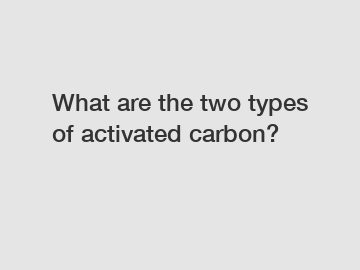What are the two types of activated carbon?
What are the two types of activated carbon?
Activated carbon is a versatile and widely used adsorbent that finds applications in various industries, including water treatment, air purification, and medical treatments. Its ability to remove impurities and contaminants has made it an essential component in many processes. However, not all activated carbon is created equal. There are two primary types: powdered activated carbon (PAC) and granular activated carbon (GAC). In this article, we will explore the characteristics, uses, and advantages of each type.
1. Powdered Activated Carbon (PAC):

Powdered activated carbon is a finely ground form of activated carbon. It has a smaller particle size compared to GAC, which enables it to have a higher surface area. This increased surface area enhances its adsorption capacity, making it highly effective for various applications.
a. Water and wastewater treatment: PAC is commonly used in water treatment plants to remove organic contaminants, taste, and odor. The smaller particle size allows PAC to quickly come into contact with the water, ensuring efficient adsorption.
b. Pharmaceutical and medical applications: Due to its high adsorption properties, PAC is utilized in medical treatments, such as drug detoxification and purification processes. It can effectively remove toxins, drugs, and impurities from the body.
c. Gas and vapor purification: PAC is also employed in gas masks and respirators to filter out harmful gases and vapors. Its fine particles enable it to capture contaminants efficiently, ensuring the safety of individuals exposed to hazardous environments.
2. Granular Activated Carbon (GAC):
Granular activated carbon consists of larger-sized particles and is commonly used in applications where a higher contact time is required. It offers several advantages over PAC due to its distinct properties.
a. Water filtration: GAC is extensively used in water filters and commercial water treatment systems. Its larger particle size allows for better flow rates and longer contact time with the water, ensuring thorough adsorption of contaminants.
b. Industrial processes: GAC serves as a crucial component in industrial processes like solvent recovery and air filtration systems. It effectively removes volatile organic compounds (VOCs), odor-causing substances, and other impurities from gases and liquids.
c. Aquarium and pool maintenance: GAC plays a vital role in maintaining the water quality in aquariums and swimming pools. It removes chlorine, harmful chemicals, and contaminants, ensuring a healthy environment for aquatic life and swimmers.
Advantages of PAC and GAC:
Both PAC and GAC have their own set of advantages, and the choice between them depends on specific requirements and application.
a. PAC offers fast adsorption due to its smaller particle size, making it suitable for applications that require quick purification or shorter contact time.
b. GAC, on the other hand, provides a longer contact time due to its larger particle size, enabling it to effectively remove contaminants that require a more extended period of adsorption.
c. Both types of activated carbon can be regenerated and reused multiple times, making them cost-effective solutions in the long run.
Conclusion:
Activated carbon plays a crucial role in various industries. Understanding the differences between powdered activated carbon (PAC) and granular activated carbon (GAC) is essential in choosing the right adsorbent for specific applications. Whether it's for water purification, air filtration, or medical treatments, the selection of the appropriate activated carbon type will ensure optimal adsorption efficiency, enabling the desired outcomes in a cost-effective manner.
If you are looking for more details, kindly visit graphite electrode uses, Gpc Columnar Recarburizer, Peach Shell Activated Carbon.
167
0
0

Comments
All Comments (0)